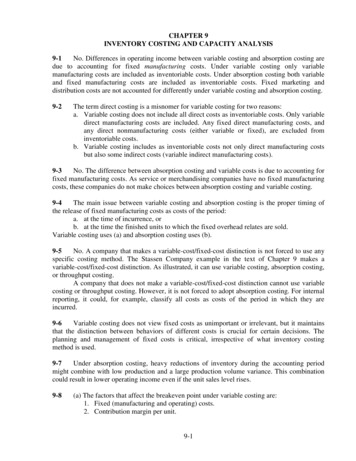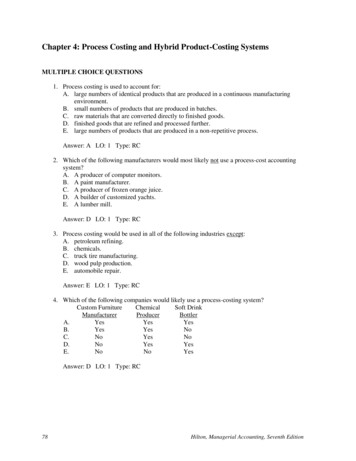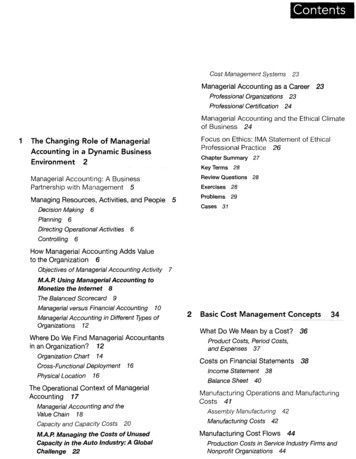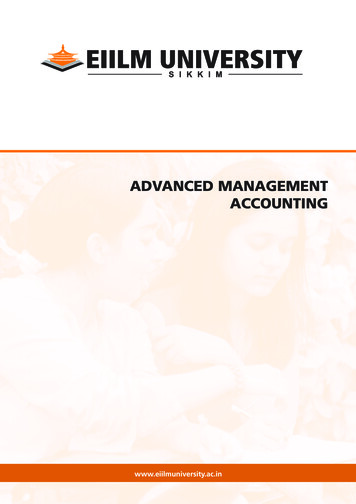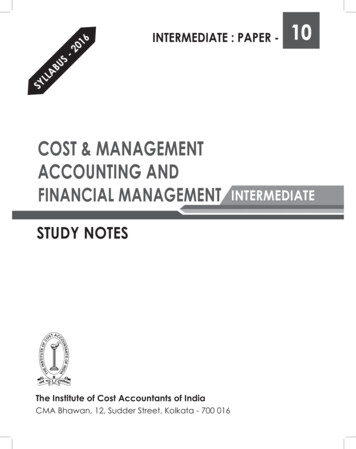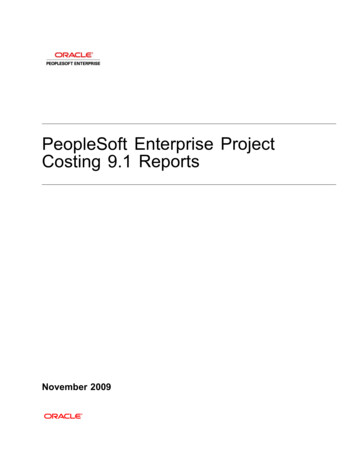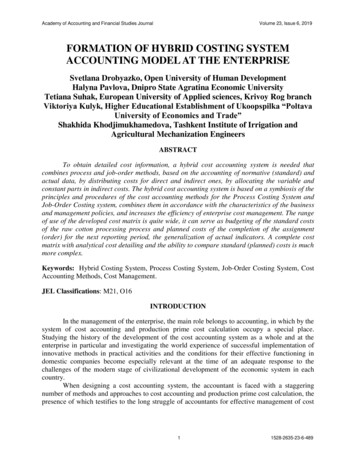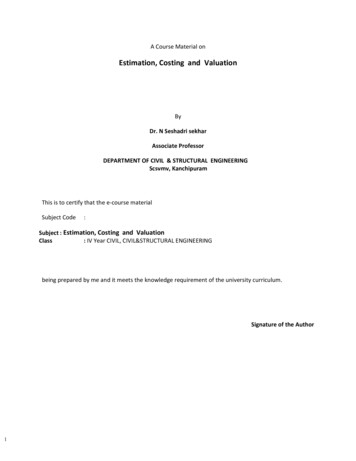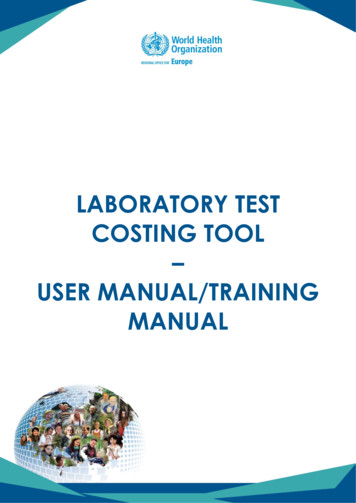
Transcription
LABORATORY TESTCOSTING TOOL–USER MANUAL/TRAININGMANUAL
Address requests about publications of the WHO Regional Office for Europe to:PublicationsWHO Regional Office for EuropeMarmorvej 51DK - 2100 Copenhagen Ø, DenmarkAlternatively, complete an online request form for documentation, health information, or for permission toquote or translate, on the Regional Office website (http://www.euro.who.int/pubrequest). World Health Organization 2019All rights reserved. The Regional Office for Europe of the World Health Organization welcomes requests for permission toreproduce or translate its publications, in part or in full.The designations employed and the presentation of the material in this publication do not imply the expression of anyopinion whatsoever on the part of the World Health Organization concerning the legal status of any country, territory, cityor area or of its authorities, or concerning the delimitation of its frontiers or boundaries. Dotted lines on maps representapproximate border lines for which there may not yet be full agreement.The mention of specific companies or of certain manufacturers’ products does not imply that they are endorsed orrecommended by the World Health Organization in preference to others of a similar nature that are not mentioned. Errorsand omissions excepted, the names of proprietary products are distinguished by initial capital letters.All reasonable precautions have been taken by the World Health Organization to verify the information contained in thispublication. However, the published material is being distributed without warranty of any kind, either expressed orimplied. The responsibility for the interpretation and use of the material lies with the reader. In no event shall the WorldHealth Organization be liable for damages arising from its use. The views expressed by authors, editors, or expert groupsdo not necessarily represent the decisions or the stated policy of the World Health Organization.
Laboratory Test Costing Tool User ManualContentsAbbreviations . iiIntroduction . 1Purpose . 1Presentation of the tool . 1Data Entry Results worksheet . 2Reagents and Consumables worksheet. 2Equipment worksheet . 2Personnel worksheet . 3Facility worksheet. 3Quality Management worksheet. 3Method used to calculate the cost of a test. 3How to use the tool . 4Data entry and results worksheet . 5Reagents and Consumables worksheet. 7Equipment worksheet . 9Personnel worksheet . 11Facility worksheet. 11Quality Management worksheet. 12Language worksheet. 12Note . 12i
Laboratory Test Costing Tool User ManualAbbreviationsBLBHBetter Labs for Better HealthELISAEnzyme-linked immunosorbent assayEQAExternal Quality AssessmentIQCInternal Quality ControlHRHuman resourcesIHRInternational Health Regulations (2005)LFMLaboratory Financial MinuteLTCTLaboratory Test Costing ToolPATHigh Threat Pathogens TeamSOPStandard Operating Procedure(s)QCQuality ControlQMQuality ManagementWHEWorld Health Emergency ProgrammeWHOWorld Health Organizationii
Laboratory Test Costing Tool User ManualIntroductionIn alignment with the Maputo Declaration on Strengthening of Laboratory Systems and the Health2020 European Policy for health and well-being, the WHO Regional Office for Europe launched theBetter Labs for Better Health initiative in 2012. This initiative is an intersectoral approach aimed toimprove the quality of laboratory services and it is a principal part of WHO’s efforts to assist MemberStates to accomplish their commitment under the IHR core capacity implementation. Better Labs forBetter Health builds on the premise that sustainable laboratory services require a rational approachto laboratory system strengthening. A crucial component of an efficient laboratory system is havinga comprehensive overview on laboratory expenditures and actual cost of tests.Better Labs for Better Health advocates for clear organization of laboratory systems at allhierarchical levels within a country, including the development of clear terms of references, testsand methods for each level. To support this, Better Labs for Better Health has developed thelaboratory test costing tool (LTCT) to help laboratories evaluate the cost of a specific laboratory test,justify this cost and produce pricelists for laboratory tests.PurposeThe LTCT is designed to calculate the cost of a specific laboratory test. The LTCT can be used byvarious professionals including: policy-makers;health economists and administrators;Ministry of Health (MoH) representatives; andlaboratory directors, coordinators and quality managers.Presentation of the toolThe LTCT is an MS Excel spreadsheet with six worksheets.Fig. 1: Worksheets in the LTCTAltering or renaming worksheet names, cell labels or protected fields can result in calculation errorsand possibly compromise the interpretation of the data. Any changes to these parameters shouldonly be made by the Better Labs for Better Health development team.A language selector allows the tool to be displayed in English, French, Russian and Ukrainian.The How to use the tool section of this guide provides an example of how to enter data in the LTCT.1
Laboratory Test Costing Tool User ManualData Entry Results worksheetYou use this worksheet to enter all general data and laboratory variables for the calculation of thecost of the test – for example, the currency to be used.You also use this worksheet to change the language of all the worksheets. English, French, Russianand Ukrainian are currently available.Fig. 2: Language selectionClick on the yellow language cell to activate the selector arrow to open the drop-down list oflanguages.Changing the language does not change the tool’s functionality in any way.Reagents and Consumables worksheetYou use this worksheet to calculate the costs of reagents and consumables, and to gatherinformation concerning procurement (ordering reference) of reagents and supplies used in thelaboratory.This worksheet describes the number of units in one package of reagents and the number of unitsused for each patient sample. This allows you to calculate the price of reagents and consumables fora patient’s test, which will be added to the total costs.The worksheet also contains information on Quality Control (QC) and Calibrators and estimates thenumber of tests used to run QCs and calibrations.The costs of all consumables such as gloves, masks, gowns etc. are entered using this worksheet.Equipment worksheetYou use this worksheet to specify equipment costs (acquisition price) and status (number of serviceyears (year expected for equipment to be used for testing), its identification and costs ofmaintenance.This worksheet is divided into General equipment (e.g. biosafety cabinets, thermostats, automaticpipettes, refrigerators etc.) and test-specific equipment (e.g. PCR machines, various analyzers,microplate washers, microplate readers (spectrophotometer)).The worksheet automatically calculates the annual amortization value of the equipment, theequipment use price per day and the per laboratory financial minute (LFM).2
Laboratory Test Costing Tool User ManualPersonnel worksheetYou use this worksheet to calculate the cost of the total number of personnel involved in performingspecific tests and all the related personnel costs.An additional 20% is added to the total cost of personnel to cover administrative personnel costs,such as: Administrative and management personnelQuality and biosafety managersLaboratory directorHuman resources personnelIn the tool, the percentage can be adjusted. It is up to the users’ discretion to add the cost foradministrative personnel.The user can use the actual size and profile of the laboratory and type of organization to adjustestimation.Facility worksheetYou use this worksheet to calculate costs related to the facility, e.g. rent, maintenance, gas andheating, water, electricity and communications.Quality Management worksheetYou use this worksheet to calculate the cost of quality management, including costs of proficiencypanels and annual audits.Method used to calculate the cost of a testThe LTCT uses the Laboratory Financial Minute (LFM) as a measurable unit to estimate the cost of atest. The tool uses the Equipment, Personnel and Facility worksheets to calculate the cost of 1 LFM.Explanation of Formula: The cost of a single test is estimated as the sum of the Cost of 1 LFM forEquipment, Personnel and Facility, multiplied by the calculated LFM value for the test added to thecost of R&C and QM for the test. See the example of calculations in How to use the tool.3
Laboratory Test Costing Tool User ManualFig. 3: Formula for cost of testCost of1 LFM equipmentreagents and 1 LFM personnel Calculated LFM valuefor 1 testconsumables (1 test) Cost of quality1 LFM facilitymanagement(1test)The Reagents and consumables (R&C) and Quality management (QM) worksheets do not use LFM,but calculate the cost of a single test based on the total costs of inputs.How to use the toolTable 1 describes the colour-coding of the cells in the LTCT.Table 1: Colour-coding and content of the LTCT data cellsTool: Colour legendBlackFixed titles and totalsWhiteGeneral information and legendsGreyAutomated calculations – protectedBlueData to be entered by userGreenReference data to be entered by the userCells coloured in green in the user manual are reference data cells – these cells are for the user to fillin for quality purposes and they will not affect the formulas and calculations but are there for yourlaboratory to look back to for reference in the future. Although this data is not mandatory to use thetool, this can be used as a reference for quality management reasons.4
Laboratory Test Costing Tool User ManualData entry and results worksheetThe Data entry and results worksheet contains two tables – the Data entry and Results tables: Enter all necessary data and numbers in the blue cells in the Data entry table.The Results table contains only grey cells, which the user cannot enter data in (they areprotected). These cells automatically use the formula described above to calculate the costof a single test based on the data entered into the worksheets in the LTCT.Table 2: Entering data in the Data entry tableData entry tableHelpful Hints and ExamplesName of teste.g. BrucellaYearOptional dataTesting area(scope)Optional dataIntended useOptional dataSample typeOptional dataMethodOptional dataCommercial (or inhouse) test kitOptional dataTime needed torun one testingbatch(minutes)Enter the time (in minutes) toperform one testing batch(testing run). This is actualworking time of the technicianand/or specialist. It can beestimated according to theLaboratory Testing User Manual/testing SOP description.How much time does it take to do theanalysis of this test?Lab WorkingHours per dayEnter the number of workinghours per day.How many hours a day is your laboratoryopen?Remember, if the laboratory isresponsible for pre- analytical work, thetime it takes to do that is added here, ifnot, only put the time it takes to do theanalytical part of the test. Enter thenumber in minutes.Enter in hours. Ex: 8Lab Working Daysper year:Enter the number of workingdays per calendar year. Anaccounting/ financial calendarcan be used. This can beestimated using the laboratory“opening-hours” profile (e.g.24/7 duty, Mon-Fri, Mon-Sat).5How many working days is yourlaboratory open in a whole year?For example:Usually it is 240 days, not accounting forholidays. If the laboratory is open onweekends, account for these days aswell.
Laboratory Test Costing Tool User ManualLab WorkingWeeks per year:Enter the number of workingweeks (usually 50-52).How many working weeks is yourlaboratory open in a whole year?Divide how many days you are open in awhole year and divide by how many daysin the week you are open.For example: 240 (open days a year) /5 (open days a week) 48 weeksTesting schedule(times per week)Enter the number of times youperform the test in the week.How many times do you perform testper week?Ex: Twice a day for 5 days 10 runsNumber of testingbatches (runs) peryearThis cell is automaticallycalculated.The formula for this cell is C17 * C18C17 Lab working weeks multiplied byC18 testing schedule per weekFor example: 48 weeks * 12 times aweek 576 times that I run this test peryearTake note that sometimes batches havemultiple samples.Batch definition: A group of up to 20samples, sample extracts, or (includingQC aliquots) depending on the test, thatare analyzed together on the sameinstrument.Mean of tests peryearsEnter the number of tests peryear of this specific test.Remember to put the number of testsyou get per year for this specific test.This can be estimated by takingthe mean number of tests for thepast three years.For example: My laboratory receivedYear 1 – 1500 HIV samplesYear 2 – 2500 HIV samplesYear 3 – 1000 HIV samplesMy answer would be: 5000 / 3 1666.67On average the mean of tests per yearsfor HIV in my laboratory is 1667CurrencyEnter the local or internationalcurrency.Remember to use this currency for allcosts throughout the toolThe LTCT displays the calculated value of the Lab Financial Minutes (LFM)1 for a single test and thetotal cost of a single test2 in the Data entry and results worksheet.1Data Entry & Result Cell C262Data Entry & Result Cell C336
Laboratory Test Costing Tool User ManualReagents and Consumables worksheetTable 3: Entering data in the Reagents and consumables worksheetHere we describe how to enter the data in the Reagents and consumables worksheetReagents and consumables worksheetCategoryEnter the category ofreagent or the name of theconsumable.Ordering ReferenceEnter the ordering referencefor reagent or consumable.Name of reagent orconsumableEnter the commercialname/manufacturer.Number units per packageEnter the number of unitsper kit/package/box.Package priceEnter the price.Unit used per patient sample1) Enter the number ofreagent units used for asingle patient test. Reagentunits can be estimatedaccording to the LaboratoryTesting User Manual /testingSOP description.2) Enter the consumableunits. These can beestimated according to thetesting method/technology,according to laboratorybiosafety practices andinternal SOPs.How many units are there perpackage or box?How many units do you use for asingle patient test?For example:For consumables that are not forone time use only. Make surethat you accurately calculate theamount by using the calculationbelow.If you can use this consumable2x per patient sample put 0.50for units used per patientsample.1 unit / 2 times .50 units usedper patient sample1 unit / 50 times .02 units usedper patient sample7
Laboratory Test Costing Tool User ManualQCper 1 batch (run)Enter the number of QCunits used for a single testingbatch (run). QC units can beestimated according to theLaboratory Testing UserManual /testing SOPdescription.Calibratorsper 1 batch (run)Enter the number ofcalibrator units used for asingle testing batch (run).Calibrator units can beestimated according to theLaboratory Testing UserManual /testing SOPdescription.Only enter data here if it is notincluded in test kitsQuality Control - the use of control materials to monitor the accuracy and precision of all theprocesses associated with the examination (analytic) phase of testing3.Calibrators - are solutions with a specified defined concentration that are used to set or calibrate aninstrument, kit, or system before testing is begun. Calibrators are often provided by themanufacturer of an ndle/10665/44665/9789241548274 eng.pdf;jsessionid 400E8D69C192B279B3C1E954CA48384D?sequence 1(Page 65/44665/9789241548274 eng.pdf;jsessionid 400E8D69C192B279B3C1E954CA48384D?sequence 1(Page 79)8
Laboratory Test Costing Tool User ManualEquipment worksheetTable 4: Entering data in the Equipment worksheetEquipment WorksheetIdentificationGeneral Equipment: Enter thetype of general equipment.This equipment is not testspecific and can be used fordifferent methods.Specific Equipment: Enter thetype of test-specificequipment. This equipment isessential for test performance.Information can be taken fromthe Laboratory Testing UserManual /testing SOP.Name/ManufacturerEnter the commercial nameand manufacturer.Acquisition price (without tax)Enter the acquisition price.Any equipment donated to thelaboratory should still have anestimated price to account foramortization for futureequipment.Example:If a donated equipment canhave a lifetime of 5 years, theprice placed here will give thelaboratory an opportunity toallocate some cost forpurchasing the next equipmentafter 5 years.Number of yearsEnter the expected lifetime ofthe equipment. The estimatednumber of years theequipment will be in useaccording to nationallegislation or themanufacturer’s description.Maintenance contract cost peryearEnter the cost of maintenanceas specified in the contract.9How long will you be able touse this equipment for?Indicate number in years.
Laboratory Test Costing Tool User Manual% of use for method /dayEnter %. This can be estimatedaccording to the number oftests and methods used onthe same item of equipment.Data needed in minutes:A: Time needed to run onetesting batch (minutes), this isthe data entered in the DataEntry and Results page cellB14.B: Total time used for thisequipment for all methods perday. Add the different timeneed to run one testing batchfor ALL methods in thisequipment.Formula:A / B * 100 % of use for method per dayExample:I want to calculate the % of use for method per day for my ELISAmachine for HIV testing in my laboratory.The time needed to run one testing batch for HIV is 40 minutes(A).I use my ELISA machine for 4 different types of testing per day HIV – 40 minutesHepatitis C – 30 minutesHepatitis B – 100 minutesE.Coli – 120 minutesThe total time used for this equipment for all methods is40 40 100 120 290 minutes per day (B)40/290*100 13.79%10
Laboratory Test Costing Tool User ManualPersonnel worksheetTable 5: Entering data in the Personnel worksheetPersonnel worksheetCategory of laboratorypersonnelEnter (list) thepersonnel involved intesting individually.Remember to enter salaries that youwant to be accounted in the cost of aspecific test.Example: If the head of the laboratory ispaid by the state, their salary should notbe included here.Personnel identificationEnter the name of themember of personnel.Annual salaryEnter the personnelmember’s annual salaryincluding taxes.Facility worksheetTable 6: Entering data in the Facility worksheetFacility worksheetMonthly Rent costFacility costs should be based on datagathered by the accounting office.EnterRemember to enter facility costs thatyou want to be accounted in the cost ofa specific test. This is up to the user’sjudgement.Building maintenancecosts/monthEnterGas and heating cost/monthEnterWater cost/ monthEnterElectricity cost/ monthEnterInternet/telephoneEnterOther costsEnter any other facilitycosts not specifiedabove.11
Laboratory Test Costing Tool User ManualQuality Management worksheetTable 7: Entering data in the Quality management worksheetQuality management worksheetQuality ManagementActivitiesEnter different quality management activities such as proficiencytesting or annual auditingPriceEnter the price of the activities# total number of methodsbeing auditedEnter the number of methods that were inspected during theaudit.Language worksheetAny modification of the wording in the module’s worksheets should ONLY be done in the Languageworksheet, because the cells in the other worksheets refer to cells in this worksheet. This worksheetis hidden; changes to cell labels etc. can therefore only be done by the Better Labs for Better Healthdevelopment team.NoteYour changes and improvements may be of interest to us as this is still a developing project. Wekindly ask you to send us your new version or revised version to the following email addresses:eulab@who.int12
The WHO RegionalOffice for EuropeThe World Health Organization (WHO) is aspecialized agency of the United Nationscreated in 1948 with the primaryresponsibility for international health mattersand public health. The WHO Regional Officefor Europe is one of six regional officesthroughout the world, each with its ownprogramme geared to the particular healthconditions of the countries it serves.Member sBelgiumBosnia and yNorth MacedoniaPolandPortugalRepublic of MoldovaRomaniaRussian FederationSan TajikistanTurkeyTurkmenistanUkraineUnited KingdomUzbekistanWorld Health OrganizationRegional Office for EuropeUN City, Marmorvej 51, DK-2100 Copenhagen Ø, DenmarkTel: 45 45 33 70 00 Fax: 45 45 33 70 01Email: eucontact@who.intWebsite: www.euro.who.int
laboratory test costing tool (LTCT) to help laboratories evaluate the cost of a specific laboratory test, justify this cost and produce pricelists for laboratory tests. Purpose The LTCT is designed to calculate the cost of a specific laboratory test. The LTCT can be used by various professionals including: policy-makers;
